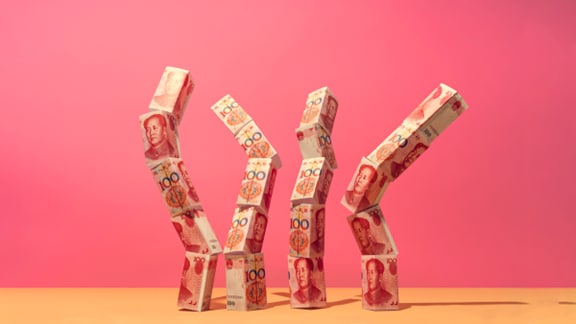Even as the world's major economies fell into negative growth when the Wuhan virus stuck in 2020, China managed to grow its gross domestic product (GDP) by 2.2 percent. Incredible!
In 2022, when the Wuhan virus made a resurgence and Xi Jinping imposed his draconian Zero-Covid Policy, China's economy still managed to grow by three percent. Amazing!
In 2023, China declared an economic expansion of 5.2% amid a debt crisis, a collapse in foreign direct investment, capital flight to the tune of $3 trillion, record youth unemployment, eroding household wealth, and weak consumer demand. Unbelievable!
How does the Chinese Communist Party (CCP) achieve such impressive growth rates on their economy despite debilitating headwinds?
A deep dive into the numbers shows how a fundamentally damaged economy hides behind favorable economic growth.

(Source: X)
China's Spending Spree Has Been Financed By Debt
What constitutes GDP in the first place? Using the expenditure method, it is the sum of personal consumption plus private sector investments plus government spending plus exports minus imports.
In as far as China's personal consumption is concerned, we all know that it has hovered in negative territory for years due to the collapse of the property sector and consequent wipe-out of some 70 percent of household wealth. Consumption is so weak that over a million restaurants and food retailers have closed across the country. That said, we can factor out personal consumption as a driver of growth.
Private sector investments are also on the decline. Due to the CCP's restrictive policies on foreign firms and expatriates, net foreign direct investments turned negative for the first time since data was collected on FDI 25 years ago. The exact amount is unclear, but economists estimate the offload of FDIs in 2023 to be in the region of $500 billion. Private investments are not an economic driver either.
Neither are net exports. While China enjoyed a trade surplus of $823.22 billion in 2023,[1] it was not enough to offset the combined negative impact of personal consumption and private investments.
So, this leaves us with government spending as the sole driver of growth. Indeed, government spending has fueled the Chinese economy's positive growth despite intense headwinds. And herein lies the problem: China's spending spree has been financed by a mountain of debt.
Debt, Debt And More Debt
When Xi Jinping assumed power in 2013, he reversed many of the capitalist policies imposed by his predecessors, the very policies that made China wealthy. He created and strengthened state-owned enterprises (SOE) as a vehicle to control many aspects of the Chinese economy. According to the University of Singapore, as much as 40 percent of China's $14.8 trillion economy was attributed to SOEs as of the end of 2020. Xi effectively restored centralized state control over the economy through his army of SOEs.
The expansion of SOEs were financed by debt. China's debt-to-GDP ratio was a mere 41 percent in 2014. It ballooned to 77 percent of GDP by 2022. But this is just the tip of the iceberg. There are trillions of dollars of debts that remain undeclared.
The CCP caps the amount of debts local governments may acquire. In the same vein, it demands a minimum rate of economic growth. Hard-pressed to meet its expansion targets, local governments have developed a backdoor to fill their financing needs without breaching the debt cap allowed by the CCP. It is a facility called the Local Government Financing Vehicle (LGFV)
LGFV is a special entity set up by local governments to finance infrastructure and other public works projects. It allows local governments to raise funds, often through bonds issuance or loans, while circumventing the borrowing limits imposed by the central government. The LGFVs are hidden debt. It is China's dirty secret.
Estimates from Guosheng Securities, a state-run financial services company, put local government debt at $11.3 trillion as of 2022. Bloomberg estimates that China's real debt to GDP ratio is a staggering 286.1 percent.[2]
China's Growth Is Driven By Massive Government Spending, Financed By Debt, Not By An Increase In Productivity
It would not be a problem if the infrastructure projects financed by debts are profitable. Guosheng reported that about one-third of recent projects do not provide sufficient financial returns, hence, are virtual white elephants. Many of the projects are redundant but built nonetheless to meet the CCP's growth targets.
Exacerbating matters is that two-thirds of corporate debt were acquired by SOEs, which are mere proxies of government. Hence, the obligation to pay still falls on the government's shoulders.
We are beginning to see what is happening here. While headline GDP tells an impressive story, the conditions behind it are a cause for worry. China's growth, despite the headwinds, is driven by massive government spending and financed by debt, not by an increase in productivity.
It is no surprise that an environment for deflation is forming. We have already seen China's consumer price index fall to negative territory since July 2023.
As we all know, deflation is vicious cycle. Weak household demand leads to price slashes that cause an erosion of profits and even business closures. This leads to decreased production output, which in turn causes a drop in employment and wages. With rising unemployment and less expendable income, consumer demand weakens even more.
With plunging productivity, many question whether China still has the bandwidth to service its mountain of debt. Remember, deflation makes government debt bigger in real terms.
Sure, a large chunk of debts is denominated in the yuan, so government can simply print money to pay for them. Although inflationary, it is still manageable. But what about China's foreign-denominated loans?
Either way, what we are seeing is a self-induced economic timebomb. Xi's need to tell the world that China's economy remains strong and resilient, even at the cost of acquiring unmanageable debts, can be the downfall of the Chinese economy and Xi himself.
*Andrew J. Masigan is the MEMRI China Media Studies Project Special Advisor. He is a Manila-based economist, businessman, and political columnist for The Philippine Star. Masigan's articles in MEMRI are also published in The Philippine Star.





